UX research is a fairly complex process with a wide array of ins and outs—all essential to extracting actionable insight to inform your design decisions.
The complexity of user experience research starts to unravel early in the planning stage. There are subsets, subgroups and even combinations of methods that can be used to understand your users.
Being able to find the best combination of methods and devise the best-suited methodology for your product is a big part of the success of your research phase.

Download the UX Research Plan Template
Let us help you start your UX Research Project on the right foot.
Download nowIt’s also important to factor in that different products have different business opportunities, UX maturity, user base size, company mission, current relation with users, and so forth—making this process all the more complicated.
But we’re here to help you out. In this article, we’ll take a closer look at the types of UX research, how you should go about processing and analyzing the data you’ve extracted, and the essential steps of the process.
Okay, what is UX research?
At its core, UX research is a systematic and organized study of users that aims to assist a product team’s decision-making, allowing it to be more user-focused and actionable.
An important aspect of this practice is observing users and analyzing the systems in which they operate. As a result, this allows researchers and designers to uncover the behaviors, needs, and motivations of the people for which a particular product is designed.
When it comes to the research methods that a team can employ, they exist on a spectrum ranging from behavioral and attitudinal methods to qualitative and quantitative methods. We’ll explore these dimensions in more depth below. Let’s touch on the value that UX research brings to the table.
The value of UX research
A common rebuttal to studying users involves ROI. Businesses often choose to skip this step since they consider it a waste of time and resources, suggesting that its price to value ratio is simply not worth it.
The ROI of UX research is a complicated topic, given that there is a wide array of improvements that can remain undocumented or can simply not be documented. However, even with that in mind, this practice has a very strong case.
For instance, a report published by McKinsey suggests that when UX is done right, it can yield a return of up to 300%.
“What our survey unambiguously shows, however, is that the companies with the best financial returns have combined design and business leadership through a bold, design-centric vision clearly embedded in the deliberations of their top teams.”
— McKinsey & Company, The Business Value of Design.
Furthermore, it’s impossible to talk about the ROI of UX research without touching on the returns that UX design generates as a whole simply because the former is a critical part of the latter. Without research and the empathy that it yields, whatever design work is done—it’s by no means user-centric. Plus, the value of UX design as a whole has been proven beyond reasonable doubt long ago. A great example of a study that analyzed the performance of organizations that chose to invest in user experience has shown that data-driven and design-oriented businesses have outperformed the S&P by a whopping 228%. This report was published back in 2014.
Here are a few more stats:
According to a report published by IBM, every dollar invested in UX returns from $10 to $100;
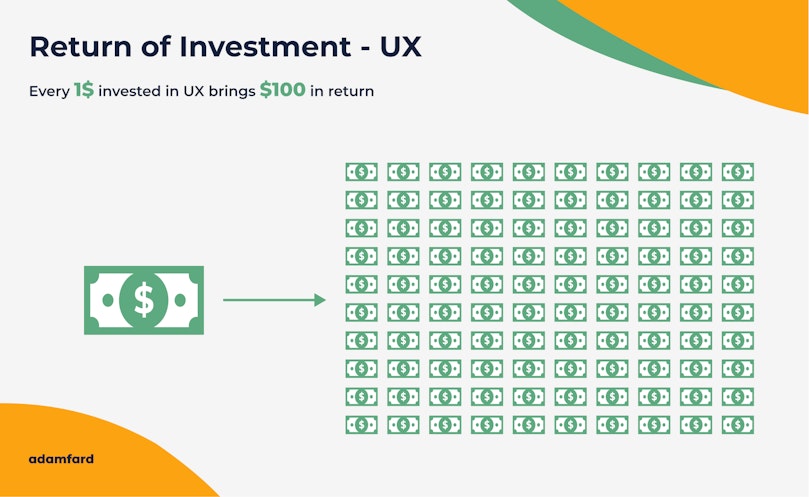
Staples skyrocketed their online revenues by 500% after a more user-oriented website redesign;
Jared Spool, the founder of User Interface Engineering, has projected that a simple tweak to the UI of Amazon has contributed roughly $2.7 billion in revenue;
But let’s shift from cold numbers and look into the benefits of the practice.
UX research allows organizations to inform and guide design, product, and marketing decisions;
It allows to evaluate the quality of a design in accordance with users’ needs and expectations;
It enables you to interpret and analyze data more reliably;
It helps users successfully complete tasks, making your product more usable, useful, and enjoyable;
Research helps you identify who your product’s early adopters will be, enabling your marketing and UX teams to tailor their approaches accordingly;
When does one conduct UX research?
UX Research is an umbrella term that denotes the number of different methods that work best in different stages of the design process. For instance, in-depth interviews shine at the earliest stages of product design, while usability testing would be employed later once you have visual solutions.
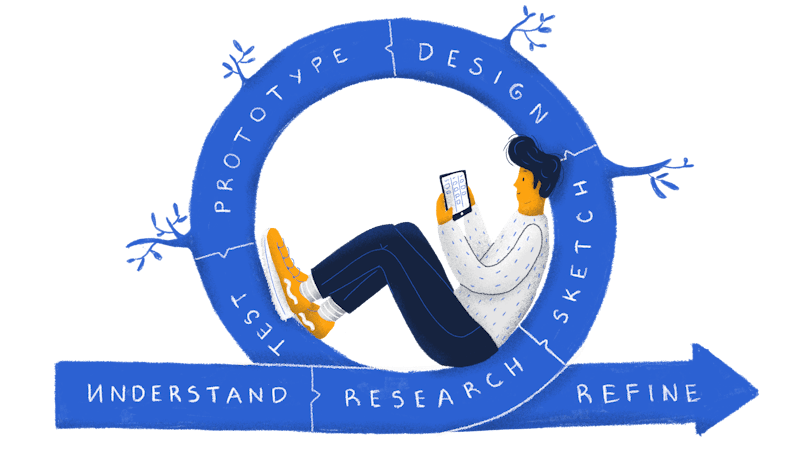
A schematic of an agile UX design process.
Nevertheless, it should be noted that UX research is an ongoing set of activities that don’t have an end. What you have instead are iterations.
Say you finish working on your personas early into the product development. That doesn’t mean that it’s going to remain set in stone till the end of days. Personas need to be constantly updated and reiterated so that your product decisions have solid ground behind them. A similar principle applies to virtually all other UX research methods.
All in all, UX research methods should always be running in the background. On top of that, you will also encounter problems and questions that need tackling, which is an invitation for research.
UX research steps
Okay, let’s now take a closer look at the process behind the UX process and the steps you need to strategize and plan it. You can think of it as a framework that will allow you to incorporate research throughout the design process and ask the right questions before you do so.
Define your goals and research
The goals of the research are generally first outlined by the person or the team that kickstarts the research process. We did mention that any amount of insight into your users is valuable for your product, but still, conducting research for the sake of research risks providing you with unsatisfactory returns on your investment. Therefore, it’s imperative that you take your time to carefully define the goals you’d like to achieve through specific research methods.
And it’s fair to say that “clear goals” is a very loose term, which is why we’ve outlined some essential criteria for a well-defined set of goals:
Use a SMART framework when setting goals (they have to be specific, measurable, achievable, relevant, and time-bound);
Make sure that your priorities, needs, and expectations aren’t subject to various cognitive biases or logical fallacies. For instance, it isn’t that complicated to identify confirmation bias in most cases—being honest with yourself and the people around you is paramount;
Don’t worry if not all the observations you make are measurable. Instead, focus on actionability;
Be aware of the effort vs. benefit of applying a method or verifying a hypothesis;
Focus on answering the fundamental questions like, “Does it drive the understanding forward?” and “How does this impact the design process?”.
Identify research methods and gather data
Based on the goals you’ve outlined, you need then to decide which research methods fit your needs and resources. Naturally, you’ll have to factor in a series of constraints like time, number of users you can talk to, your research team capacity, and so forth. Whatever the constraints, it’s important to mention that even the tightest of circumstances can yield a wide array of valuable insight, provided there’s goodwill and expertise.

A table of cost and time for each research method | Find the full table in our template.
That said, the next step is merely executing what is planned. The methods themselves require some planning and coordination as well so that the insights you get are actionable and tackle the exact questions you need answers to.
Analyze, interpret, synthesize data
Collecting data is exciting, but analyzing it is a totally different animal. More importantly, your approach will differ significantly depending on the type of information you’ve collected throughout your user research process.
Fundamentally, we can divide research methods into qualitative and quantitative, and we can further classify them as behavioral and attitudinal.
When it comes to processing and interpreting quantitative data, your main goal is to develop insights by identifying patterns in the users’ behavior. Typically, most of the quantitative analysis in UX revolves around variables such as success rates, task times, and error rates.
However, it’s worth mentioning that qualitative data can be attitudinal in nature as well. Satisfaction questionnaires are a good example of that.
When it comes to qualitative data, your approach might differ slightly due to how different it is from quantitative information. While it is very diverse and subjective, there are still commonly agreed-upon principles on how this data should be handled and processed. A common method is thematic analysis, which can be performed via software (CAQDAS, also known as Computer-Aided Qualitative-Data–Analysis software), journaling, affinity diagramming, and so forth.
To extract more insight from your qualitative data, we suggest asking some of the following questions:
Have you identified any outstanding patterns and themes in the users’ answers?
Have there been any answers or remarks that surprised you? Why?
Have you identified any questions or parts of your research that caused an emotional response from the participants?
Were you able to identify new user stories from the studies you’ve conducted?
Were there any features and functions that users deemed indispensable in the product?
Do the features align with their context of use? ]
Have you identified any use cases that aren’t adequately supported by the UI?
UX research methods
Okay, so now that we’ve taken a look at the process, let’s explore UX research methods in more depth. We’ve divided them into two categories—attitudinal and behavioral studies that feature both qualitative and quantitative methods.
Attitudinal methods
Attitudinal studies yield a lot of self-reported data. The participants of your research expand on their beliefs, perceptions, and expectations. Naturally, this category will feature a lot of research methods where people tell researchers what they think about the topic at hand. Let’s take a look at some common attitudinal methods:
1. User interviews and in-depth interviews (qualitative)
What makes these types of interviews special is that you conduct them at the earliest stages of product development. They’re very exploratory in nature and allow you to lay the foundation of your product. This research method is employed when there’s little understanding of the problems users or potential users face.
2. Diary study (qualitative)
This research method involves study participants taking continuous notes and keeping records of their activities as per your instructions over some period of time.
A diary study helps you uncover habits, usage scenarios, attitudes and motivations, changes in behaviors and perceptions, customer journeys, and so forth.
We strongly recommend checking out this Nielsen Norman group guide on diary studies and how you should prepare for them.
3. Surveys (qualitative & quantitative)
Surveys are a very efficient and cost-effective research method, especially when you have very specific questions you need answers to. Unlike face-to-face interviews, your ability, surveys provide you with less flexibility.
Surveys can be both qualitative and quantitative, but it’s important to formulate questions accordingly to accommodate each research type. For instance, if you’re aiming for a quantitative study, your questions should have a yes/no structure or provide the participant with a scale to choose from, which will, in turn, allow you to quantify their answers easily. Qualitative questions, on the other hand, should aim to be open-ended and encourage exploration.
4. Card sorting (qualitative & quantitative)
Card sorting is exceptionally useful in developing the information architecture of a product. This study typically provides users with a series of elements like features, subfeatures, actions, etc., and encourages people to structure them in a way that they find meaningful.
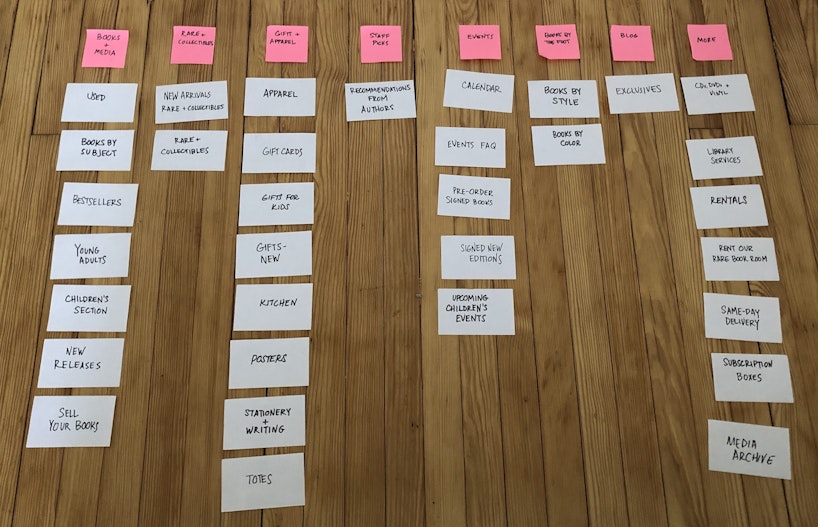
Behavioral
As you may have anticipated, behavioral methods are the complete opposite of attitudinal studies since there is a near-total lack of reporting and a lot of direct observation. Typically, participants are presented with a prototype or a finished product, while researchers document their interaction with it. The most common behavioral research methods include eye-tracking, A/B tests, product analytics, and so forth.
1. Usability testing (qualitative & quantitative)
Once you have an early visual and preferably clickable prototype of your product, you can have users interact with it to gauge feedback before committing to coding a design. Usability testing is an exceptionally cost-effective type of research since you only need five users to uncover approximately 85% of usability issues.

2. Eye-tracking (quantitative)
Eye-tracking is a very efficient way of identifying blind spots and points of confusion and finding useful patterns. While this approach can yield a lot of valuable insight fairly quickly, it’s worth mentioning that it requires somewhat expensive special equipment. If you don’t have access to eye-tracking equipment, there are now plenty of AI tools that model how a person’s attention is distributed across an interface, which can provide a wealth of useful insight after your first design iteration.
3. A/B testing (quantitative)
Ideally, an A/B testing session focuses on a few specific differences in an interface so that you can compare how users interact with them. The reason it’s advisable to have fewer differences is so that you can pinpoint exactly which change in design resulted in which change in metrics.
It’s important to underline that A/B testing should be conducted when your design should, at the very least, be a high-fidelity prototype. Otherwise, your testing results may be inconclusive or lead you to incorrect assessments. Unless you know what you’re doing, we don’t recommend including too many design differences in your A/B tests.
4. Product analytics (quantitative)
A modern software toolbox offers a plethora of tools to track and monitor user behavior: Google Analytics, Mixpanel, Fullstory, and so forth.
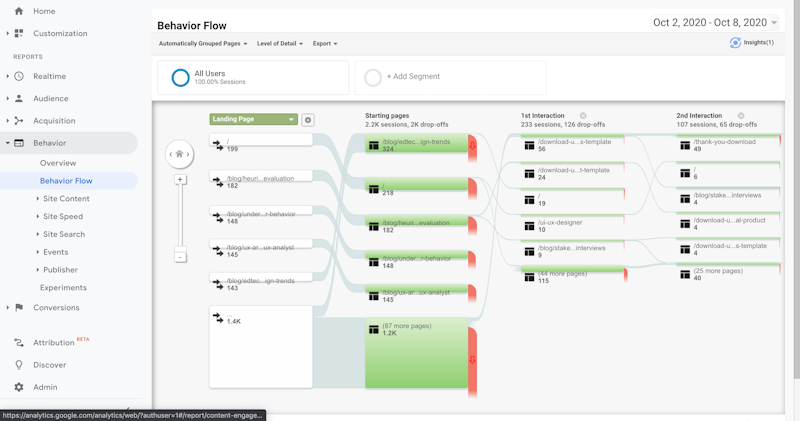
The drawback of this research method and any other purely quantitative research method is that those won’t tell you the whole story, like why people choose to do what they do—it will only uncover patterns and help you confirm hypotheses.
5. Heuristic evaluation (qualitative & quantitative)
Heuristic evaluation is typically used when you have already developed an interface to the degree that allows evaluating its performance.
You may be wondering what a heuristic is—basically speaking, it’s an attempt to find a solution to a problem by trial and error. In UX, a common heuristic evaluation scenario is asking a person to execute a task using an interface they have no prior knowledge about. As a result, this allows researchers and designers to assess a product’s or design’s usability.
There are multiple sets of heuristics. However, the most commonly used one is Nielsen’s usability heuristics.
On synthesizing research data
We mentioned above that running research for the sake of research is a pointless and wasteful endeavor. Once you’ve collected, analyzed, and processed your research data, it’s time to synthesize it into a series of deliverables that will further inform design decisions. Here are a few of them:
Persona
User personas don’t come out of thin air—they’re the product of extensive user and market research, and it’s absolutely critical to leverage your findings to craft detailed profiles of your customers.
Everybody knows you need one. Unfortunately, only a select few actually go beyond a generic description that ends up collecting the proverbial “dust” on Google Drive.
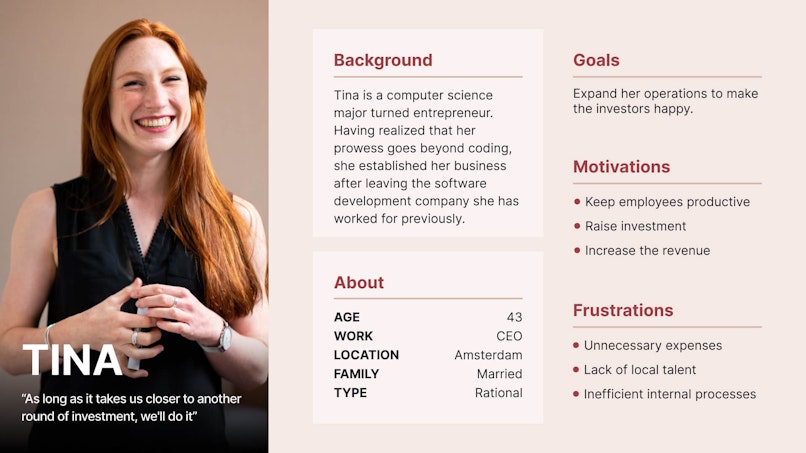
Information architecture
Your IA is a blueprint of some sort for the product you’re creating. Think of it as the art of organizing the information presented in an interface. Like user personas, information architecture demands a lot of research to inform it—most commonly card sorting exercises and sometimes usability testing.
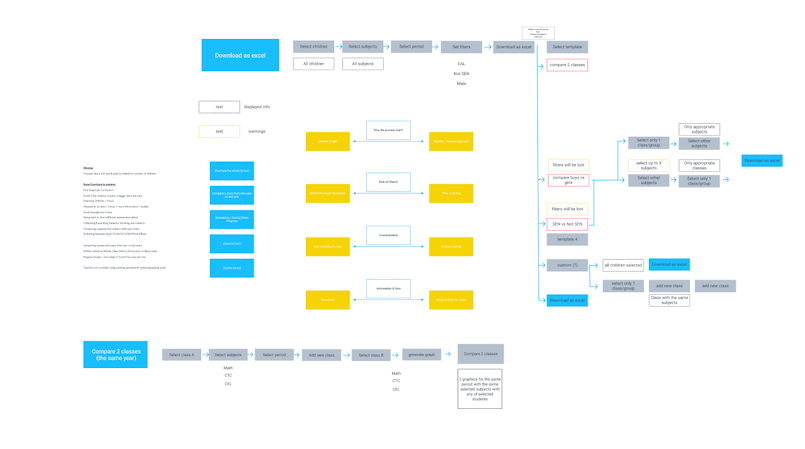
Customer journey mapping (CJM)
A customer journey map is basically a persona in action. It’s an attempt to walk in your users’ shoes by mapping their interaction and relationship with your business over time. While persona tells you who your user is, the CJM tells you about their path from being a complete stranger to a long-term, loyal customer.

Empathy map
Quite often, there’s a discrepancy between what users say, think, do, and feel. These differences aren’t trivial for product design, as they have a massive impact on your design and how people will interact with your product. The fundamental purpose of an empathy map is to strengthen your persona and foster empathy in your team.
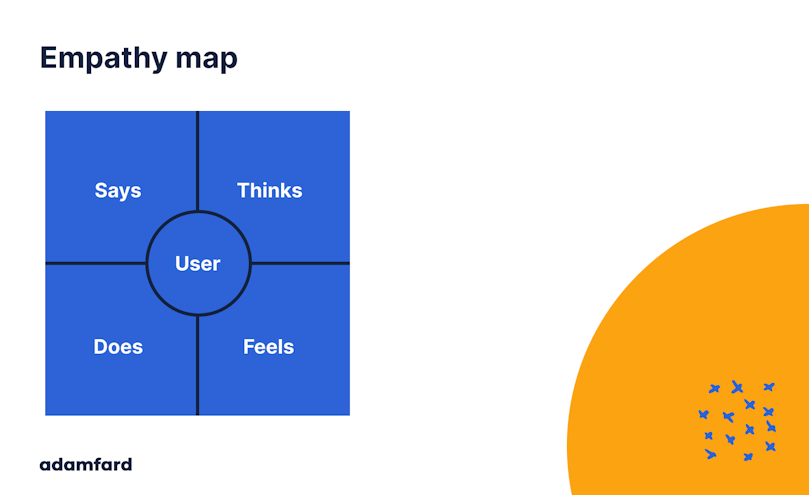
Storyboarding
At its face value, a storyboard is a comic about a specific situation in your user’s life. While it may be easy to dismiss this practice as a waste of time, it remains an invaluable tool in a UX designer’s arsenal that allows for fostering empathy within a team. It’s easier to empathize with “a real” person than with a couple-dozen-page report on how an abstract user behaves.
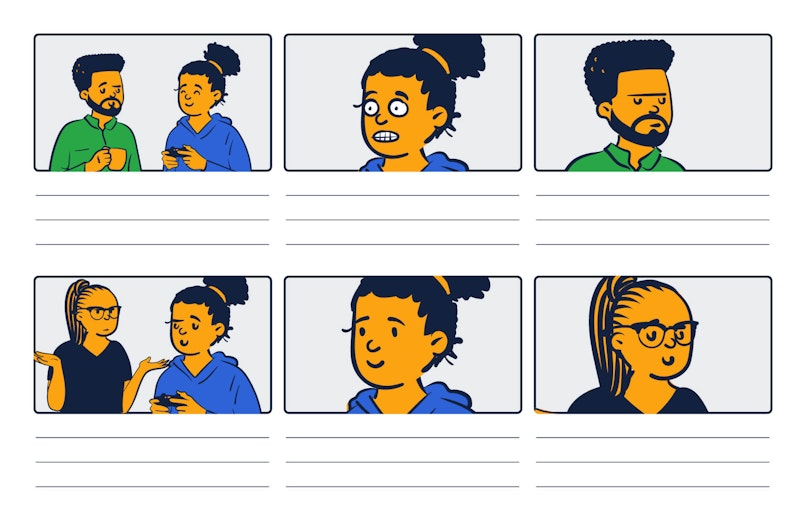
The bottom line
UX research is an extremely complex process—there’s so much more to cover. However, we’re confident that this article will provide you with the fundamentals you need to start conducting your own studies or, at the very least, consider it.

Download the free UX Research Plan Template
Let us help you start your UX Research Project on the right foot.
Download now




